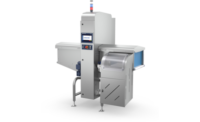How metal detectors and X-ray tech has evolved to help candy makers
The latest scanners can work with Industry 4.0, and can be installed directly alongside the weighing and packaging equipment for faster speeds.

The tna hyper-detect 5 technology can scan food vertically, and connection to industry 4.0. Photo provided by tna.
The latest metal detector equipment can be integrated with vertical packaging while also sharing real-time status updates with operators via Industry 4.0. They feature accessible, customizable touch screens; options for easy upgrades, and seamless integration within multiple parts of the production line.
But for candy makers it can be difficult to navigate when to upgrade, and which metal detectors and X-ray equipment is right for their factory when they do.
Choose the right one is extremely important though, says Donna Butler, business development manager-confectionery, at tna North America. Aside from helping to prevent recalls, they can also impact how fast product can be output.
“Confectionery manufacturers are aware of how important metal detection and x-ray stations are to ensure that packaging remains contaminant-free and to avoid a possibly damaging product recall. However, the additional advantages of these systems are often overlooked,” Butler said. “For example, in an industry like confectionery where profit margins are minimal, metal detection and other line safety systems can play an integral role in keeping operations as profitable as possible.”
The right metal detector also can identify the location of a contaminant in the product stream, remove the foreign material and eliminate excessive waste, while reducing long periods of downtime.
“Digitalization and the rise of Industry 4.0 have boosted the capabilities of monitoring equipment as much as other line components,” Butler said. “The latest examples of this type of detection system – such as the tna hyper-detect 5 – offer benefits like faster validation tests, seamless data pairing, and the option to share fail-safes with other systems.”
Indeed, the tna hyper-detect 5 technology also enhances production line sustainability with compact design that reduces stack height, allowing it to sit easily between the scales and tna robag packaging system. It also features a profile touchscreen or membrane electronic features. And there are options for full up- and down-stream integration options.
Another new technology available for metal detectors comes from Fortress Technology. The company’s Interceptor DF metal detector uses a simultaneous multi-frequency operation that processes the transmission and reception of multiple frequencies continuously over a broad spectrum.
Developed with Divergent Field technology, it is the world’s first metal detector to use multiple field directions. This improves the detection of ultra-thin contaminants that are often encountered in processing lines, especially among confectionery products.
Then there’s the M30 R-Series from Mettler Toledo.
Built around the leading-edge SENSE software technology, it brings new levels of intelligence and sophistication to the mid-market metal detection field. The full-color touchscreen makes operation simple, with key tasks accessible using the quick access menu. It also can be localized at the individual user level, and programmed to one of 33 languages.
The entry-level M30 R-series GC systems are designed on a modular platform concept with streamlined features as standard. And the metal detector and conveyor can be easily upgraded as compliance or production requirements change. This helps manufacturers to achieve a lower overall cost of ownership and extend the useful life of their equipment, supporting sustainability aims.
Finding the right place in the factory for a metal detector
However, before candymakers even look at equipment, they need to look at their own production line.
“Manufacturers need a comprehensive understanding of their production line and how and where the detection equipment will fit,” Butler said.
They need to determine exactly what types of contaminants they need to detect, the product volume for the typical products they expect the detector to process, and what type of packaging will need to be scanned through the machine.
“With a good understanding of this information, site managers can effectively choose the right detection equipment for their needs,” Butler said.
Then, when looking at specific equipment, at a bare minimum, Butler said the selected system should be capable of identifying ferrous and non-ferrous metal and non-magnetic stainless steel — typically the most challenging to detect.
Beyond that, manufacturers should consider which advanced features they want, such as a wider range of operating parameters including precise contaminant size and operating frequency.
Then, when it’s time to install the new equipment, candymakers need to position it strategically to ensure fast throughput.
“Metal detection and x-ray systems should be located at strategic points along the production line so they can identify potential contaminants as early as possible,” Butler said. “Confectionery manufacturers can identify the best places for these inspection points with the help of industry guidelines like the Hazard Analysis Critical Control Point (HACCP) methodology. With these checkpoints in place, the cost of reworking or losing products to unnecessary giveaway can be reduced dramatically.”
Moreover, to further improve efficiency, candy manufacturers can opt for a vertical fall or gravity-based metal detector. These systems feature a compact design which allows installation directly alongside the weighing and packaging equipment - significantly increasing bagging speeds.
Looking for a reprint of this article?
From high-res PDFs to custom plaques, order your copy today!







